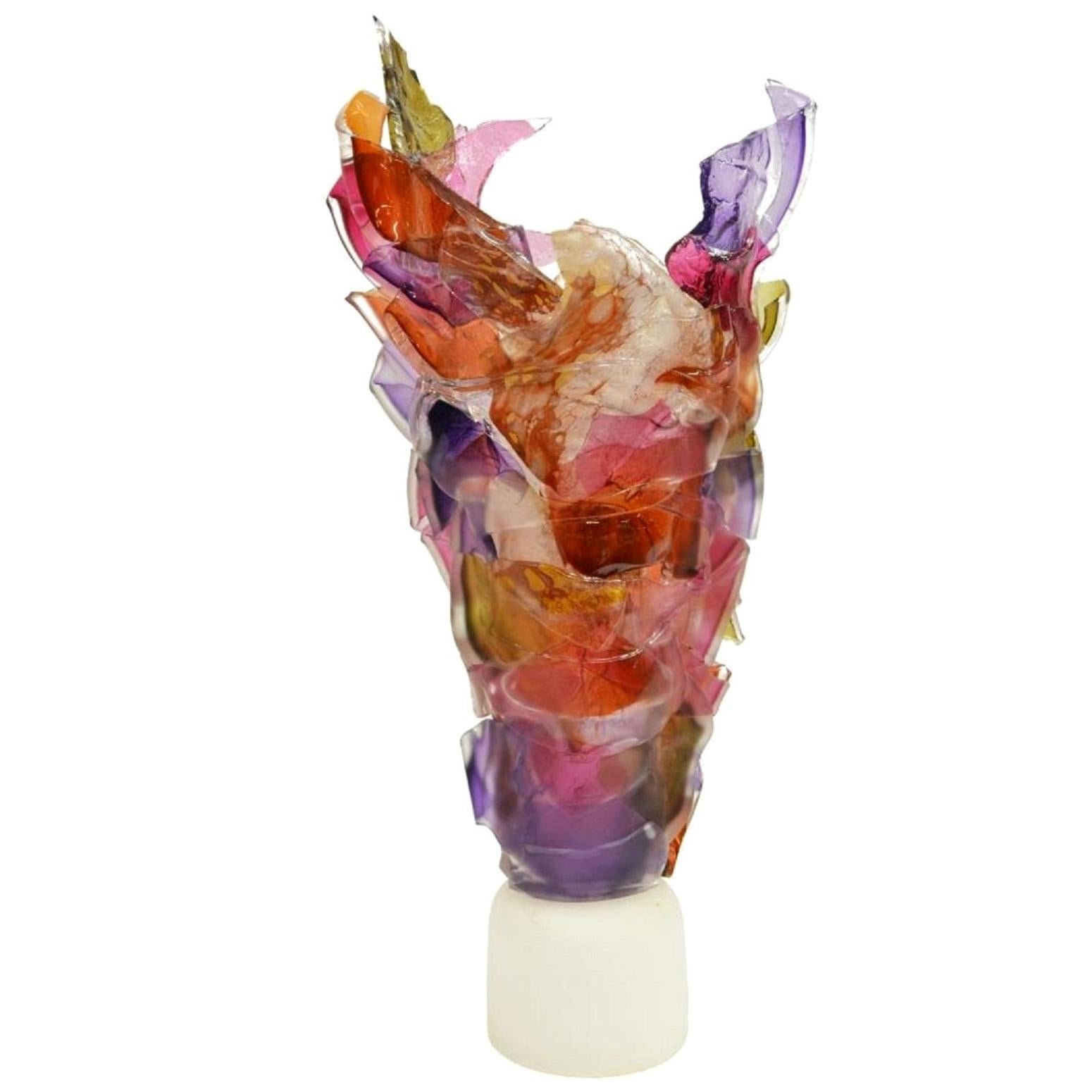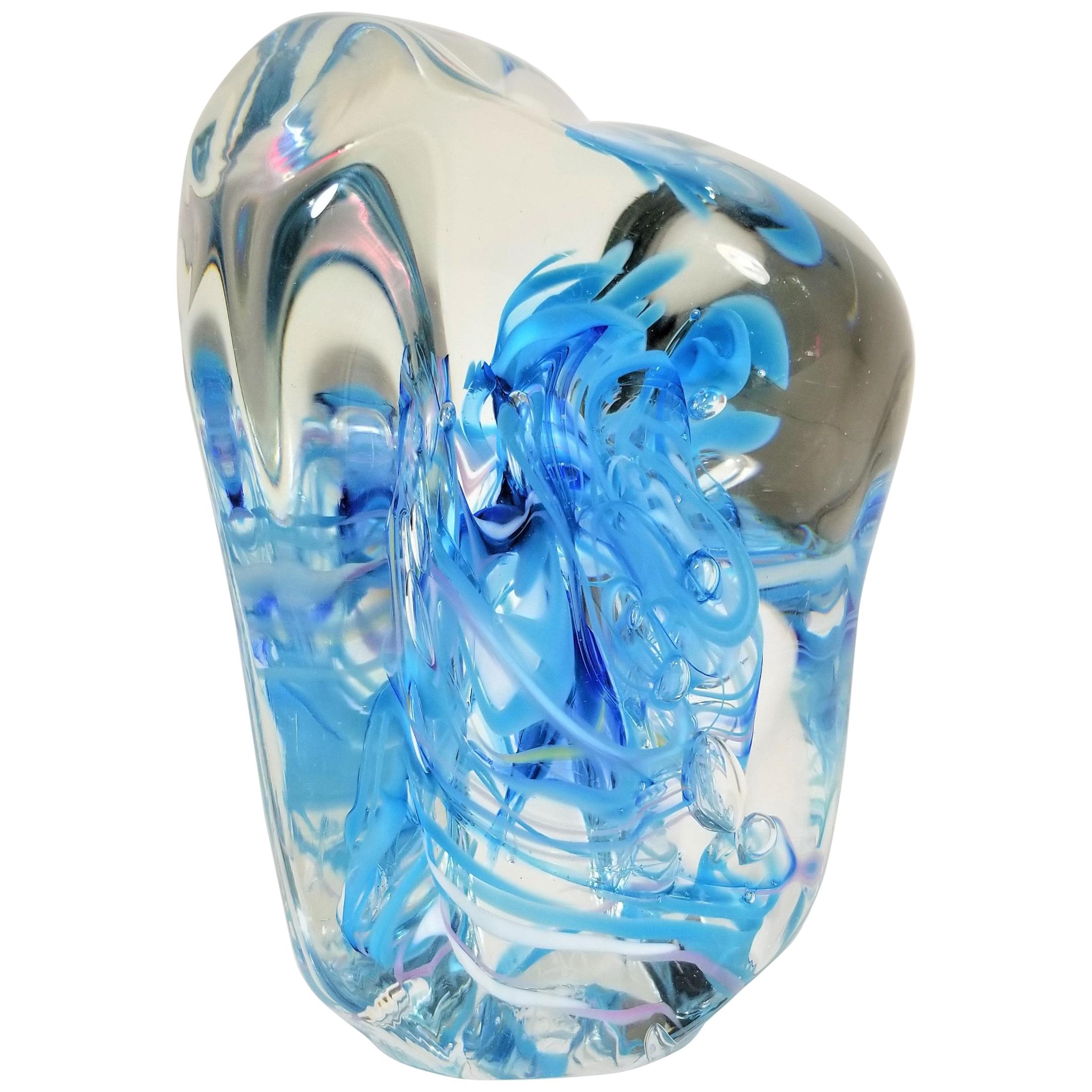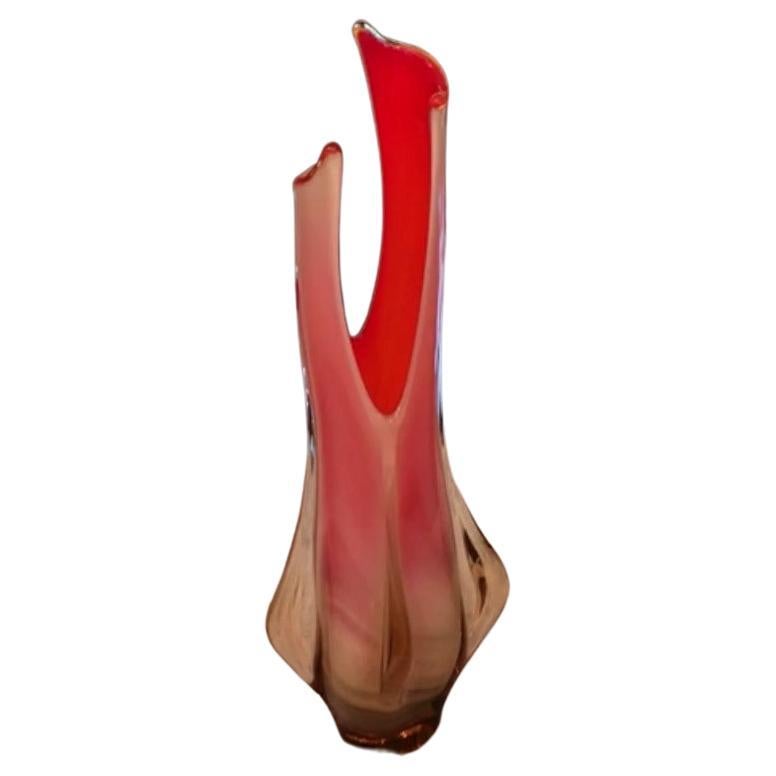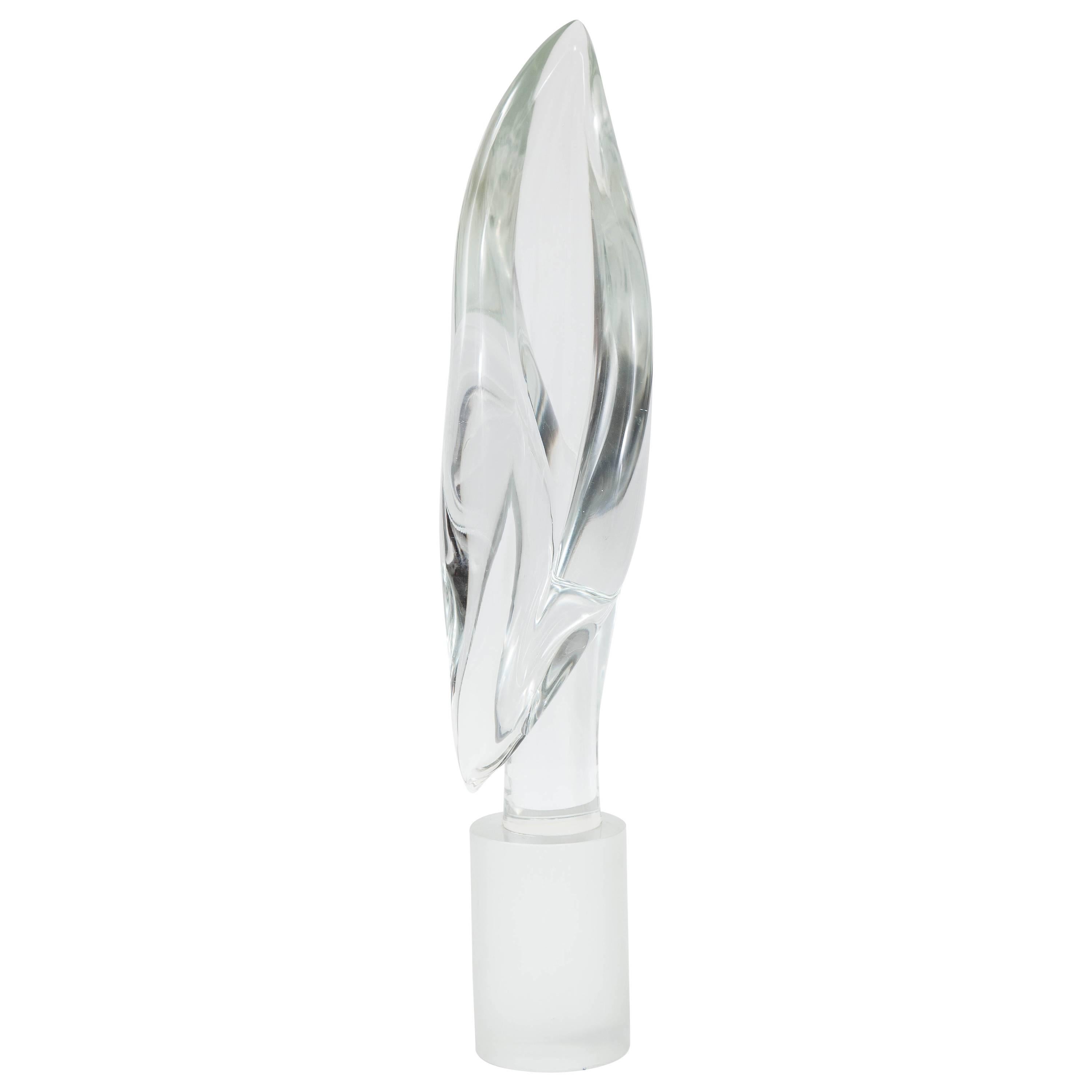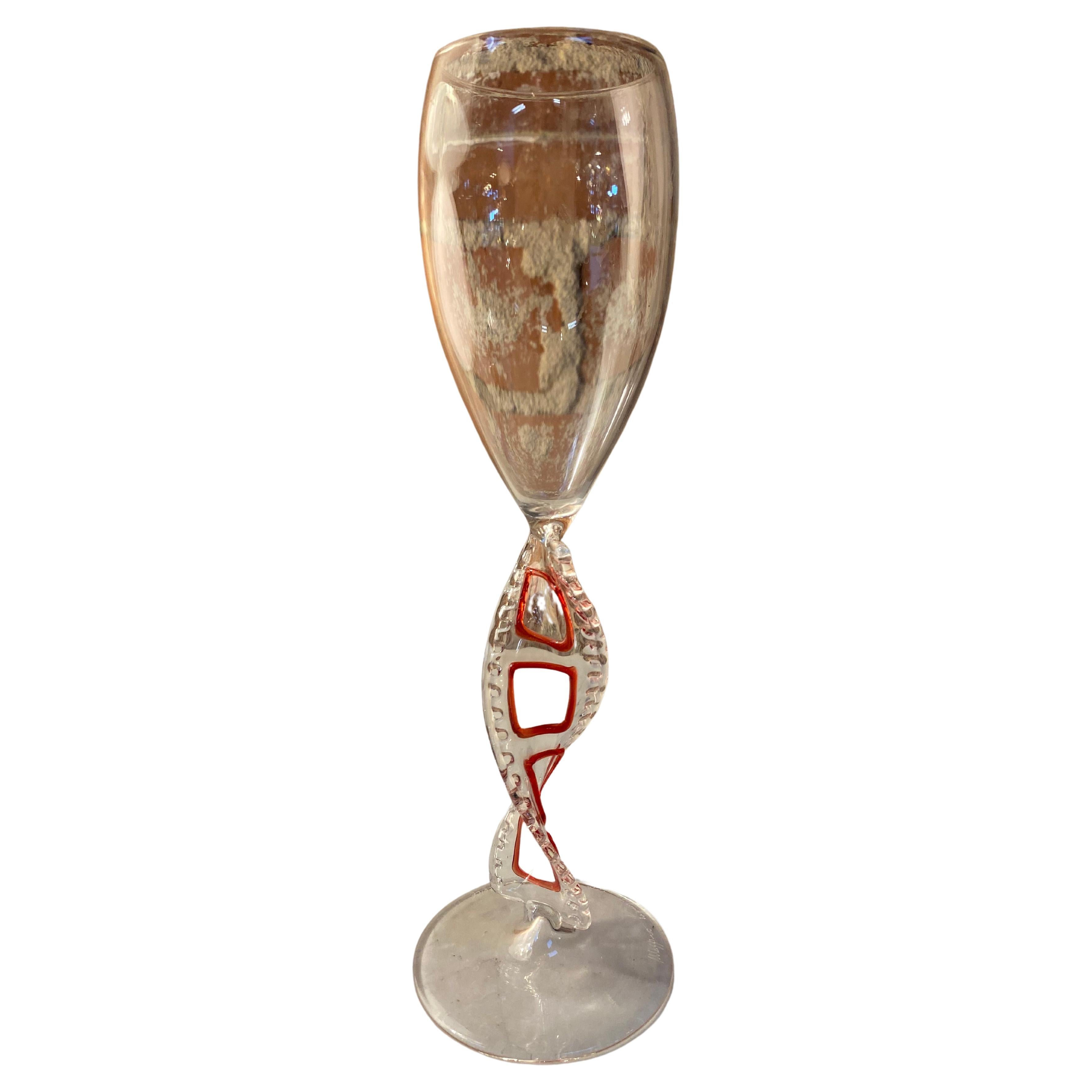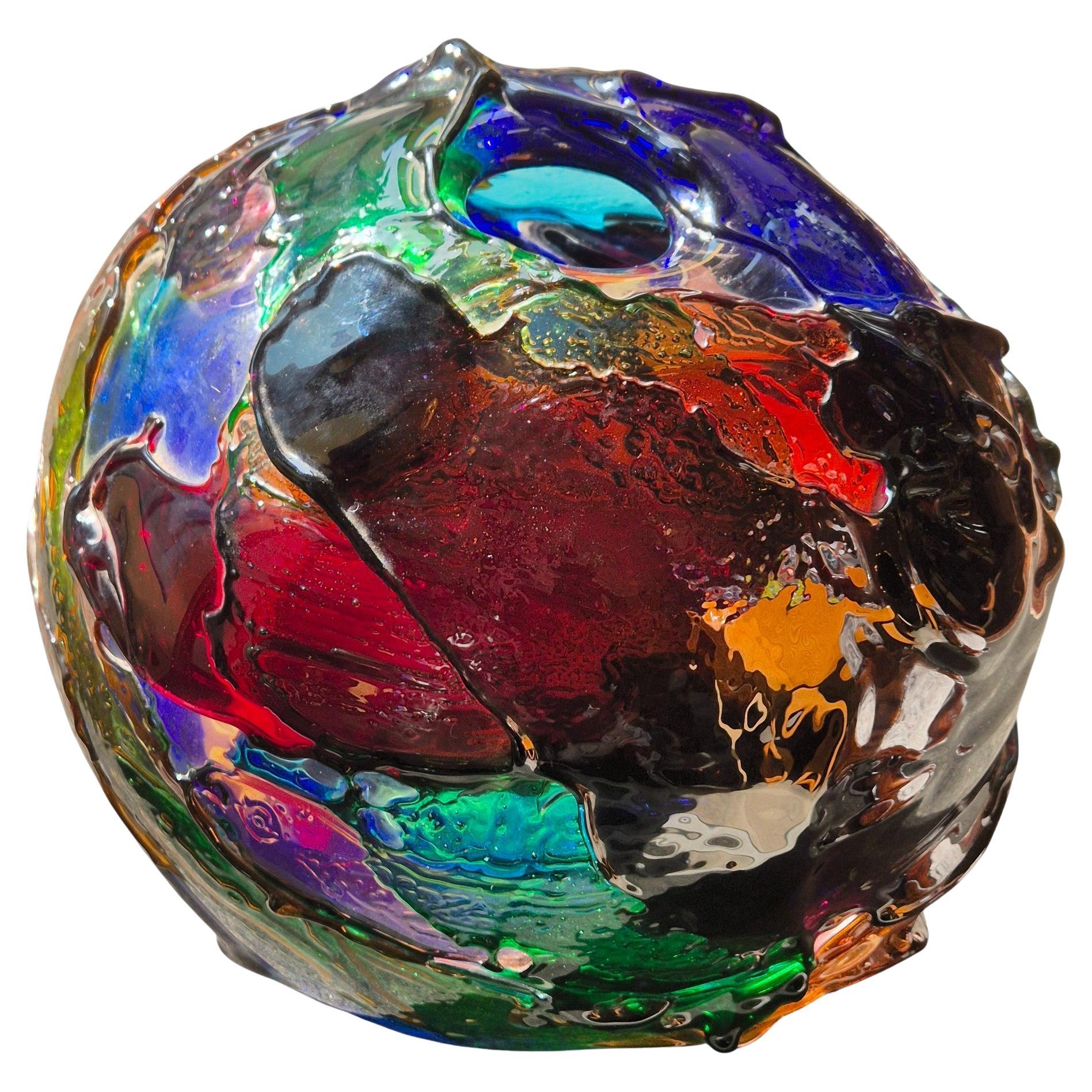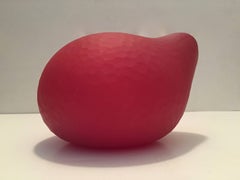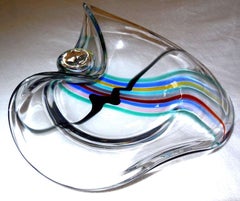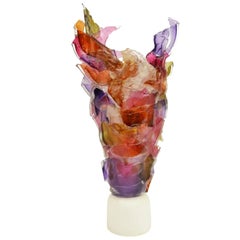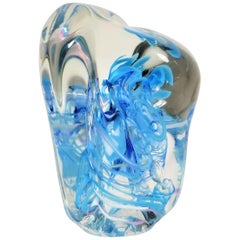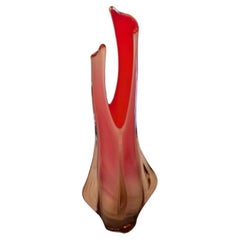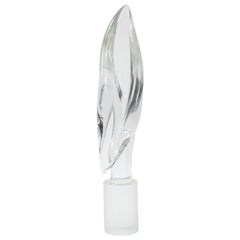Items Similar to Early Murano Glass Free Form Abstract Blown, Cut, Glass Sculpture in Bronze Vase
Want more images or videos?
Request additional images or videos from the seller
1 of 9
UnknownEarly Murano Glass Free Form Abstract Blown, Cut, Glass Sculpture in Bronze Vasec.1930s-1940s
c.1930s-1940s
$1,200
£916.68
€1,053.17
CA$1,715.74
A$1,890.35
CHF 978.56
MX$22,760.28
NOK 12,390.92
SEK 11,640.48
DKK 7,863.96
About the Item
This piece appears unsigned and unmarked. It came from an important estate in the Palm Beach area.
It is an abstract flame or torch in a bronze vase.
Venetian glass (Italian: vetro veneziano) is thought to have been made for over 1,500 years, and production has been concentrated on the Venetian island of Murano since the 13th century. Murano glassmakers created cristallo—which was almost transparent and considered the finest glass in the world. Murano glassmakers also developed a white-colored glass (milk glass called lattimo) that looked like porcelain. They later became Europe's finest makers of mirrors. Murano glassmaking began a revival in the 1920s. Today, Murano and Venice are tourist attractions, and Murano is home to numerous glass factories and a few individual artists' studios. Its Museo del Vetro (Glass Museum) in the Palazzo Giustinian contains displays on the history of glassmaking as well as glass samples ranging from Egyptian times through the present day.
The Venetian glassmakers of Murano are known for many innovations and refinements to glassmaking. Among them are Murano beads, cristallo, lattimo, chandeliers, and mirrors. Additional refinements or creations are goldstone, multicolored glass (millefiori), and imitation gemstones made of glass.
Aventurine glass, also known as goldstone glass, is translucent brownish with metallic (copper) specks.
Calcedonio is a marbled glass that looked like the semi precious stone chalcedony. This type of glass was created during the 1400s by Angelo Barovier, who is considered Murano's greatest glassmaker. Ercole Barovier, a descendant of Murano's greatest glassmaker Angelo Barovier, won numerous awards during the 1940s and 1950s for his innovations using the murrine technique.
Sommerso is a form of artistic Murano glass that has layers of contrasting colors (typically two), which are formed by dipping colored glass into another molten glass and then blowing the combination into a desired shape. The outermost layer, or casing, is often clear. Sommerso was developed in Murano during the late 1930s. Flavio Poli was known for using this technique, and it was made popular by Seguso Vetri d'Arte and the Mandruzzato family in the 1950s. This process is a popular technique for vases, and is sometimes used for sculptures.
Some of Venice's historical glass factories in Murano remain well known brands today, including De Biasi, Gabbiani, Venini, Salviati, Barovier & Toso, Pauly, Berengo Studio, Seguso, Formia International, Simone Cenedese, Alessandro Mandruzzato, Vetreria Ducale, Estevan Rossetto 1950 and others. The oldest glass factory is Antica Vetreria Fratelli Toso, founded in 1854.
About the Seller
4.9
Platinum Seller
Premium sellers with a 4.7+ rating and 24-hour response times
Established in 1995
1stDibs seller since 2014
1,816 sales on 1stDibs
Typical response time: 1 hour
- ShippingRetrieving quote...Shipping from: Surfside, FL
- Return Policy
Authenticity Guarantee
In the unlikely event there’s an issue with an item’s authenticity, contact us within 1 year for a full refund. DetailsMoney-Back Guarantee
If your item is not as described, is damaged in transit, or does not arrive, contact us within 7 days for a full refund. Details24-Hour Cancellation
You have a 24-hour grace period in which to reconsider your purchase, with no questions asked.Vetted Professional Sellers
Our world-class sellers must adhere to strict standards for service and quality, maintaining the integrity of our listings.Price-Match Guarantee
If you find that a seller listed the same item for a lower price elsewhere, we’ll match it.Trusted Global Delivery
Our best-in-class carrier network provides specialized shipping options worldwide, including custom delivery.More From This Seller
View AllMasterpiece Swiss Contemporary Blown Faceted Cut Glass Sculpture Vase
By Thomas Blank
Located in Surfside, FL
Thomas Blank was born in Berne, Switzerland, in 1973. He is a master of transformation, who has been investigating the nature of glass for 20 years now, without losing his fascination for the versatility of this unique material. On his artistic voyage towards ever more sublime expression, he creates marvelous vitreous objects, both in terms of shape and color. The reflections, refractions, and optical illusions are especially appealing, and challenge the perception of the viewer. Thomas Blank is both an artist and a craftsman. During his art studies in San Francisco, he already used to work both as a glass-melting technician and as a glass-blower, and he attended workshops by the famous Michael Schunke and Michael Schreiner. Later, he learned the Venetian technique from Josiah McEleheny (1998) and became the assistant to Simone Cenedese in Murano in 2003. Today, Thomas Blank teaches courses himself, works as a lecturer, and creates objects for artists and designers around the world. His works of art have been shown in Europe, the USA, and Japan. Many of them can be seen in numerous collections, including those of the Contemporary Art Museum of Honolulu (Hawaii) and the Museum for Design and Applied Arts in Lausanne, Switzerland.
This came from an important Northern California collection that included a wonderful selection of Murano Glass. Aldo Nason, Peter Shire and Ettore Sottsass, Murano master Gigi Toso. A descendent of the legendary Venini dynasty of glassmakers, Laura Diaz de Santillana Incalmo Vases, Lino Tagliapietra, Yoichi Ohira...
Category
21st Century and Contemporary Post-Modern Abstract Sculptures
Materials
Blown Glass
Huge Seguso Murano Glass Centerpiece Sculpture
By Livio Seguso
Located in Surfside, FL
A huge centerpiece good-quality Seguso Murano (probably 1970s or 1980s, Memphis Milano era) elliptical-form clear glass sculptural bowl with striated rainbow colors of blue, orange, ...
Category
20th Century Abstract Abstract Sculptures
Materials
Glass
Vintage Hand Blown Faceted Fruit Form Murano Glass Sculpture Vase for Arcade
By Laura de Santillana
Located in Surfside, FL
Vase designed by Laura de Santillana in edition for Arcade, 2001. this is from a series of tropical fruit and plant form inspired vases with the same matte, hand engraved, finish:
PAPAIA, made in three different shades of green. MANGO, made in dark red glass. PASSION, made in an orange red glass. MARACUIA, made in golden yellow glass
COCCO, made in brown glass
Produced by maestro Simone Cenedese in Murano
Mouth-blown, hand-shaped, cut glass.
Country of Manufacture Italy. Signed by maker and sticker label from Arcade. Hand-Crafted
LAURA DE SANTILLANA
After finishing her studies, she moved to New York, where she attended the School of Visual Arts 1975 – 1977 and works with Massimo Vignelli as a graphic designer.
she returned to Italy and began her active collaboration with the Venini & C, where she came in contact with many Italian and foreign artists. During this period she used the techniques of Murano to create refined works with unusual colors, perfecting the “vetro mosaico” technique.
Her glassworks have received many prizes and recognitions, and are held by the most important museums of the world.
She collaborated with Venini between 1976 and 1985, during which she designed a range of articles. 1995 Starts collaboration with Simone Cenedese, which continues to this day.
2001-2002 Begins working in bronze and in wax sculpture at the Fonderia Brustolin, Verona
SELECT SOLO EXHIBITIONS
2018: In This Light, Galleri Glas, Stockholm
2017: Ciel Terrestre, Galerie Pierre Marie Giraud, Bruxelles
2016:Laura Diaz de Santillana, Stefan Vogdt/Galerie der Moderne, Munich
Sleeves, Caterina Tognon, Venezia
I fedeli, Studio Museo F. Messina, Chiesa di S. Sisto, Milano
2015: Laura de Santillana, O cha dogu, Ippodo Gallery, Tokyo, Japan
2014: Tokyo-ga, Ippodo Gallery, Tokyo, Japan
2013: Big Flats, Galerie L’Arc en Seine, Paris, France
2012: Laura de Santillana Meteors, David Richard Gallery, Santa Fe, NM, USA
2011: Grands Transparents, Galerie L’Arc en Seine, Paris, France
Liquid Glass, Traver Gallery, Seattle, WA, USA
2010:Laura de Santillana, Prague Festival, Istituto di Cultura Italiano, Prague, Czech
2008: Laura de Santillana, Istituto Italiano di Cultura, Los Angeles, CA, USA
2007: Khadi, Galleria Marina Barovier, Venice, Italy
2006: Bodhis, Galerie L’Arc en Seine, Paris, France
Bodhis, Barry Friedman Gallery, New York, NY, USA
2005: New Work, Sanske Galerie, Zurich, Switzerland
2001Laura de Santillana Works, Museo Correr, Venice, Italy (catalog)
Laura de Santillana Works, Barry Friedman Gallery, New York, NY, USA (catalog)
Metals, Elliott...
Category
21st Century and Contemporary Post-Modern Still-life Sculptures
Materials
Blown Glass
Vintage Hand Blown Faceted Fruit Form Murano Glass Sculpture Vase for Arcade
By Laura de Santillana
Located in Surfside, FL
Vase designed by Laura de Santillana in edition for Arcade, 2001. this is from a series of tropical fruit and plant form inspired vases with the same matte, hand engraved, finish:
PAPAIA, made in three different shades of green. MANGO, made in dark red glass. PASSION, made in an orange red glass. MARACUIA, made in golden yellow glass
COCCO, made in brown glass
Produced by maestro Simone Cenedese in Murano
Mouth-blown, hand-shaped, cut glass.
Country of Manufacture Italy. Signed by maker and sticker label from Arcade. Hand-Crafted
LAURA DE SANTILLANA
After finishing her studies, she moved to New York, where she attended the School of Visual Arts 1975 – 1977 and works with Massimo Vignelli as a graphic designer.
she returned to Italy and began her active collaboration with the Venini & C, where she came in contact with many Italian and foreign artists. During this period she used the techniques of Murano to create refined works with unusual colors, perfecting the “vetro mosaico” technique.
Her glassworks have received many prizes and recognitions, and are held by the most important museums of the world.
She collaborated with Venini between 1976 and 1985, during which she designed a range of articles. 1995 Starts collaboration with Simone Cenedese, which continues to this day.
2001-2002 Begins working in bronze and in wax sculpture at the Fonderia Brustolin, Verona
SELECT SOLO EXHIBITIONS
2018: In This Light, Galleri Glas, Stockholm
2017: Ciel Terrestre, Galerie Pierre Marie Giraud, Bruxelles
2016:Laura Diaz de Santillana, Stefan Vogdt/Galerie der Moderne, Munich
Sleeves, Caterina Tognon, Venezia
I fedeli, Studio Museo F. Messina, Chiesa di S. Sisto, Milano
2015: Laura de Santillana, O cha dogu, Ippodo Gallery, Tokyo, Japan
2014: Tokyo-ga, Ippodo Gallery, Tokyo, Japan
2013: Big Flats, Galerie L’Arc en Seine, Paris, France
2012: Laura de Santillana Meteors, David Richard Gallery, Santa Fe, NM, USA
2011: Grands Transparents, Galerie L’Arc en Seine, Paris, France
Liquid Glass, Traver Gallery, Seattle, WA, USA
2010:Laura de Santillana, Prague Festival, Istituto di Cultura Italiano, Prague, Czech
2008: Laura de Santillana, Istituto Italiano di Cultura, Los Angeles, CA, USA
2007: Khadi, Galleria Marina Barovier, Venice, Italy
2006: Bodhis, Galerie L’Arc en Seine, Paris, France
Bodhis, Barry Friedman Gallery, New York, NY, USA
2005: New Work, Sanske Galerie, Zurich, Switzerland
2001Laura de Santillana Works, Museo Correr, Venice, Italy (catalog)
Laura de Santillana Works, Barry Friedman Gallery, New York, NY, USA (catalog)
Metals, Elliott Brown Gallery, Seattle, WA, USA
SELECTED GROUP AND DUO EXHIBITIONS
Design Basel, Galerie Pierre Marie Giraud
Chromatique, MUDAC, Lausanne
Living with Art_Albion Barn, Oxford UK
Oltre Roma, Accademia d’Ungheria, Roma
Fired up: women in glass, Toledo, Museum of Art_Charlotte, Mint Museum , USA
Laura de Santillana and Alessandro Diaz de Santillana, YSP
Trésors de sable et de feu. Verre et cristal aux Arts Decoratifs, XIV-XXI siècle,
Musée des Arts Décoratifs, Paris, France
Artissima Torino, Galleria Caterina Tognon
Hourglass, Galleria Marignana, Venezia, Italy
I Santillana, MAK, Austrian Museum for Applied Arts/Contemporary Art, Vienna, Austria
Artissima Torino, Faggionato Gallery, London, UK
Fire and Form: The Art of Contemporary Glass, The Norton Museum of Art, Palm Beach, Laura de Santillana, Fashion meets Art, Giorgio Armani, New York, NY, USA
Translucency, Paul Hughes Fine Arts, London, UK
Selected Museums
Museo Vetrario di Murano, Venice, Italy
The Corning Museum of Glass, New York, NY, USA
Victoria and Albert Museum, London, UK
Metropolitan Museum of Arts, New York, NY, USA
Saint Louis Museum of Fine Arts, St Louis, MO, USA
Cooper-Hewitt Museum, New York, NY, USA
Seattle Art Museum, Seattle, WA, USA
Denver Art Museum, Denver, CO, USA
The Museum of Fine Arts, Houston, TX, USA
Carnegie Museum of Art, Pittsburgh, PA, USA
Los Angeles, Los Angeles County Museum of Art
MUDAC, Lausanne, Switzerland
MAD, Museum of Arts and Design, New York, NY, USA
Museu de Arte de São Paulo, São Paulo, Brazil
Musée des arts décoratifs, Paris, France
Kunstmuseum im Ehrenhof, Düsseldorf, Germany
Kunstsammlungen der Veste Coburg, Coburg, Germany
Museum für Kunst und Gewerbe, Hamburg, Germany
Neue Sammlung, Munich, Germany
IMA, Indianapolis Museum of Art, Indianapolis, IN, USA
Museum of Fine Arts, Boston, MA, USA
Toledo Museum of Art, Toledo, OH, USA
This came from an important Northern California collection that included a wonderful selection of Murano Glass. Aldo Nason, Peter Shire and Ettore Sottsass, Murano master Gigi Toso. A descendent of the legendary Venini dynasty of glassmakers, Laura Diaz de Santillana Incalmo Vases, Lino Tagliapietra, Yoichi Ohira...
Category
Early 2000s Post-Modern Abstract Sculptures
Materials
Blown Glass
Masterpiece Contemporary Australian Blown and Carved Glass Sculpture Vase
By Ben Edols & Kathy Elliott
Located in Surfside, FL
Provenance: Part of an important collection that had work Both Benjamin Edols and Kathy Elliott were born in Sydney. The two began working together as recent graduates from the Canberra School of Art. Ben also studied at the Royal College of Arts in Sydney.
The first exhibition of their collaborative work was in 1993. Since that time they have developed a body of work of blown and cold worked glass vessels and forms. Ben specialises in glassblowing and Kathy specialises in cold working techniques such as carving and engraving.
In 2000 they built their own glassblowing and cold working studio in Sydney. In recent years, their work has been inspired by the botanical forms and patterns found in nature. One of the qualities of glass that they most appreciate is its ability to carry light.
They have taught in Australia, America and Japan. Their work has been exhibited widely and is held in many public museums and private collections around the world including the Victoria and Albert Museum, the American Craft Museum, the National Gallery of Australia and the Auckland War Memorial Museum.
Ben Edols & Kathy Elliott
SELECTED SOLO EXHIBITIONS
Tutti, Sabbia Gallery, Sydney, NSW
Glance, Beaver Galleries, Canberra ACT
Dwell, Collector Space, Jam Factory, Adelaide. SA
Shelter, Sabbia Gallery, Sydney
Benjamin Edols Kathy Elliott, Flame Run Gallery , Louisville KY
Light Marks, William Traver Gallery, Seattle
Studio Glass, Beaver Galleries, Canberra
Benjamin Edols Kathy Elliott, Masterworks Gallery, Auckland
Evolve, Sabbia Gallery, Sydney
Edols & Elliott, Kirra Gallery, Melbourne, VIC
Recent Work, deVera, New York, NY
Cultivate II, Quadrivium , Sydney, NSW
Botanicals, de Vera...
Category
Early 2000s Post-Modern Still-life Sculptures
Materials
Blown Glass
Masterpiece Swiss Contemporary Blown Matte Glass Sculpture Vase
By Thomas Blank
Located in Surfside, FL
Thomas Blank was born in Berne, Switzerland, in 1973. He is a master of transformation, who has been investigating the nature of glass for 20 years now, without losing his fascinatio...
Category
21st Century and Contemporary Post-Modern Abstract Sculptures
Materials
Blown Glass
You May Also Like
Art Glass Sculpture by Caleb Nichols
Located in Austin, TX
Modern colorful and bright art glass sculpture by Caleb Nichols, American, 21st century.
Light and dark purple, pale and bright pink, orange, white, green, red - all these colors of frosted and clear blown glass pieces were combined together in the colorful centerpiece...
Category
21st Century and Contemporary American Abstract Sculptures
Materials
Art Glass
Murano Signed Art Glass Sculpture
Located in New York, NY
Signed Murano decorative art glass. Dated 1997. Sculptural shape. Blown glass design in varying shades of blue and white surrounded by clear glass. Substantial / Heavy in weight.
Ex...
Category
Antique Early 19th Century Abstract Sculptures
Materials
Art Glass
Murano, 1950, Italian
Located in Ciudad Autónoma Buenos Aires, C
Murano
We have specialized in the sale of Art Deco and Art Nouveau and Vintage styles since 1982. If you have any questions we are at your disposal.
Pushing the button that reads 'Vi...
Category
Vintage 1950s Italian Space Age Abstract Sculptures
Materials
Murano Glass
$2,950
Murano Glass Abstract Sculpture
Located in New York, NY
This graceful work consists of a clear glass flame-like design on a cylindrical frosted glass base. The piece has an ethereal quality about it, and can add star power to a room witho...
Category
20th Century Italian Abstract Sculptures
Materials
Murano Glass
Vintage Decorative Italian Handcrafted Murano Glass, 1970s
Located in Los Angeles, CA
Vintage decorative Italian handcrafted Chalice, 1970s.
Category
Vintage 1970s Italian Mid-Century Modern Glass
Materials
Murano Glass
vase "Sculpture" in the spirit of Gae Aulenti, Murano, Italy, signed, circa 1990
By Gae Aulenti
Located in NICE, FR
This captivating creation, in the spirit of Gae Alenti's “Geacolor” sculpture vase produced by the Venini studio, is a true collector's piece of art in the artistic tradition of Mura...
Category
1990s Italian Modern Glass
Materials
Glass
$2,655 Sale Price
20% Off
More Ways To Browse
Glass Blown Sculpture
Murano Glass Vase By Vetreria
Free Form Sculpture
Vintage Venetian Glass Vase
1920s Murano
Cristallo Chandelier
Murano Glass Barovier Toso Aventurine
Vetreria Fratelli Toso
Cenedese Simone
Calcedonio Glass
Lee Kang Hyo
Leo Schimanszky
Lettron Fabrice
Linda Lopez
Lucia Eames
Maren Ceramic
Mariusz Dydo
Marko Kratohvil On Sale
